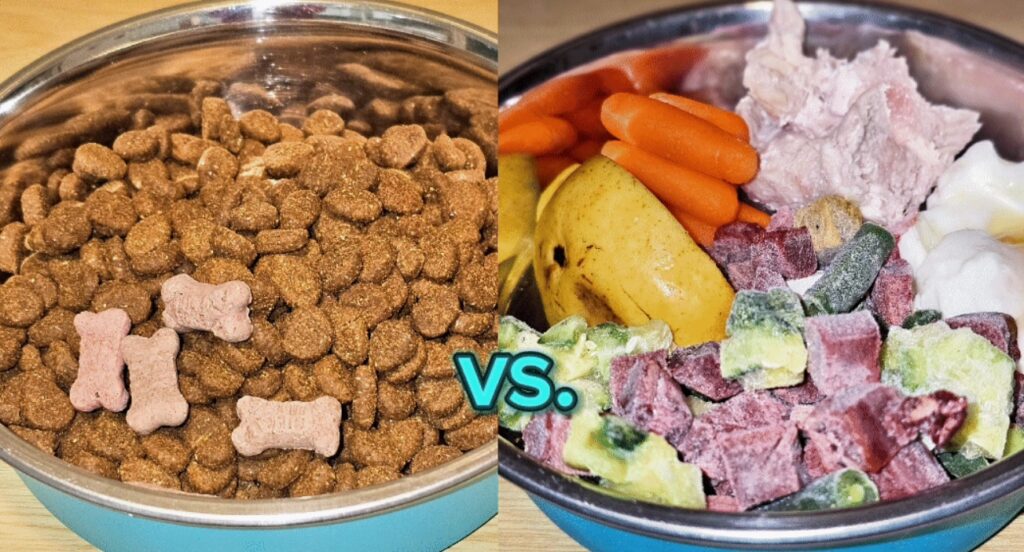The Hidden Truth About Pet Food: What the Pet Industry Doesn’t Want You to Know
As many of you might remember from my Ultimate Dog Food Guide, I’ve dedicated countless hours to researching the pet food industry to understand the truth behind food processing. But my journey didn’t stop there. I’ve recently dug deeper into the “dog food truth,”
This article will open your eyes to what’s really in your dog’s bowl. If you’re eager to learn more, don’t miss my free courses on kibble and alternative options and join my community while it is free:

The Pet Food Industry: Misinformation Campaign vs. Truth
The pet food industry is a multi-billion-dollar powerhouse that shapes our understanding of canine nutrition. Unfortunately, a significant part of its messaging is centered around profit rather than the health of our pets. We’ve been conditioned to believe that feeding our dogs exclusively from bags is the best choice. However, many of these products contain questionable ingredients, misleading labels, and fillers that can negatively impact our dogs’ health.
For years, we’ve been told that dogs are omnivores. We’ve accepted that commercial dog foods can be filled with corn, soy, and other fillers. While dogs share DNA similar to carnivorous species, they don’t benefit from the high-carb load found in these foods. This is similar to how overconsuming processed sugars harms humans. We can digest sugar, but that doesn’t mean it’s healthy. The shift to grain-free products has become a profitable rebranding. Still, grain-free is not carb-free and replaces one problematic ingredient with another without addressing what dogs truly need to thrive. Many grain-free products contain plant-based proteins from sources like peas and lentils. These can lead to heart issues and other health concerns. It’s important to recognize that a “grain-free” label does not automatically mean a product is a better choice for our dogs.
The Industry’s Deceptive Ingredients
When examining the list of ingredients for pet food, you might come across terms like “meat and meat by-product.” These vague descriptors allow companies to avoid disclosing the exact source of the ingredients. “By-product meat” can refer to a range of animal parts that may not meet the standards many pet owners would expect in their dog’s diet.
A vital part of this system is the Association of American Feed Control Officials (AAFCO). Unlike the FDA, a regulatory body, AAFCO is an association of industry representatives. While AAFCO does set nutritional standards for pet food, its members primarily represent the interests of the pet food industry, with a strong focus on profitability rather than pet health. This association is driven by the goal of ensuring that the industry remains profitable, not necessarily by prioritizing the well-being of our pets.
The definition of “meat by-product” (not specified meat type) itself is concerning. It allows for the use of ambiguous ingredients. These can include low-grade animal tissue or even diseased or euthanized animals. These by-products undergo further treatment to kill bacteria, but the focus is solely on sterilization. Nutritional quality takes a backseat. The pet industry relies on by-products partly because they have a long shelf life; some can remain stable for up to 25 years. However, this emphasis on longevity and cost efficiency often sacrifices the nutritional value pet food should provide.
The Association of American Feed Control Officials.
Below is the original definition from the AAFCO source.
“Meat and meat byproducts from animals that have died by other means than slaughter aren’t directly suitable for animal food because these products are considered adulterated. They can’t be used for animal feed unless they contain no chemical additives and are heat-treated and further processed. For dry kibble and canned pet foods, the final product should be free of disease-causing bacteria.
Because it’s difficult to store and handle raw ingredients properly in a pet food manufacturing facility, many pet food plants use rendered byproducts in a meal form.”
The Disturbing Reality of Dog Food Processing
The way pet food is processed also contributes to its questionable quality. Most commercial pet foods are produced with high heat and pressure, creating shelf-stable kibble but often lacking essential nutrients. Ingredients like “chicken meal” or “beef meal” are already a concern: they’re made from meat ground up and cooked at high temperatures before even entering the kibble-making process. Then, during kibble production, these meal ingredients undergo another round of extreme heat, further degrading any remaining nutrients. This double-cooking process strips away many beneficial vitamins and minerals, leaving the final product far from nutritionally optimal.
Kibble is essentially overcooked, and while it provides convenience, it doesn’t offer the same health benefits as fresh, whole foods. This lack of nutritional quality can lead to long-term health issues for our pets. For instance, studies have linked the consumption of well-done burgers, which contain harmful compounds produced during high-heat cooking, to an increased risk of cancer. Studies have suggested that diets high in processed foods can increase the risk of obesity, diabetes, and cancer in dogs.
Yet the evidence against processed foods, whether for humans or pets, is growing. This raises an important question: why would we subject our pets to them if we didn’t want to feed ourselves these unhealthy options?

The Lack of Accountability in the Pet Food Industry
The truth about pet food is troubling. Despite numerous recalls over the past two decades, the pet food industry prioritizes shelf life and profit over safety. Many recalled products remain on store shelves, with minimal consequences for companies. This alarming lack of accountability endangers our pets. Many brands neglect their responsibility, leading to significant recalls due to contamination, toxicity, and mislabeling. This raises serious concerns about the industry’s commitment to product safety. We must question the integrity of brands that allow such failures, as their negligence can have dire consequences for our pets’ health.
The Power of Marketing and Misinformation
The marketing strategies employed by the pet food industry often confuse pet owners, making it difficult to distinguish between genuinely nutritious options and those designed to maximize profit. Terms like “natural,” “premium,” and “organic” are frequently used without stringent regulations. This leads consumers to believe they are purchasing high-quality food when, in reality, they might be getting the same low-quality ingredients dressed up in appealing packaging.
Veterinarians are often viewed as the primary experts for pet health. However, they may lack the knowledge to navigate the complexities of pet nutrition. Many veterinary schools receive funding from pet food companies, which can influence the information given to students and, in turn, to us. This creates a cycle where veterinarians may not have access to the latest research or alternative dietary recommendations. This situation mirrors the past relationship between the smoking industry and public health. Just as doctors in the 1940s and 50s promoted cigarettes as stress relievers, today’s veterinarians often endorse processed kibble as the best solution for pet nutrition.
The Importance of Research and Education
As responsible pet owners, we must educate ourselves and be aware of potential conflicts of interest in the veterinary field. We must seek information from diverse sources, including independent research, to make informed decisions about our dogs’ diets. We are our pets’ advocates, and we are responsible for ensuring they receive the best care possible.
It’s crucial for pet owners to research and stay informed about what they’re feeding their dogs. Understanding the ingredients, processing methods, and potential health risks associated with commercial dog foods can empower us to make better choices for our pets.
While feeding our dogs table scraps is often discouraged, many fresh foods can be safe and nutritious alternatives to processed kibble. Foods like lean meats, vegetables, and even certain grains can provide essential nutrients that support our dogs’ health. We can improve their overall well-being and longevity by gradually incorporating fresh foods into their diets.
The Call for Transparency
The pet food industry is still far from transparent, and many brands prioritize profit over honesty. This lack of accountability and transparency creates an environment where we must remain vigilant about what we’re feeding our pets. By researching brands, scrutinizing ingredient lists, and being aware of marketing tactics, we can make more informed decisions about our dogs’ nutrition.
Advocating for our pets’ health is important, and we should demand transparency from the companies we support. We should push for better regulations and more stringent oversight of pet food ingredients. Ultimately, we deserve to know what is in our dogs’ food and how it affects their health.
Conclusion: Our Responsibility as Pet Owners
The truth about the pet food industry is not easy to swallow, but it’s crucial to become aware finally. Unfortunately, the industry is more interested in our money than our pets’ health. But by staying informed and scrutinizing labels, we can make educated decisions that support our pets’ health.
Every choice we make as pet parents can save or extend a dog’s life—maybe even your own beloved companion’s. As their advocates, it’s our responsibility to break free from the myths of the pet food industry and ensure they receive the love and nutrition they truly deserve. Share this truth with other pet owners, because together, we can prioritize our dogs’ well-being over profit-driven agendas and make a difference,
To learn how to start feeding better or find healthier dog food options, continue here: BETTER DOG FOOD.
